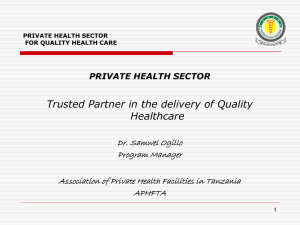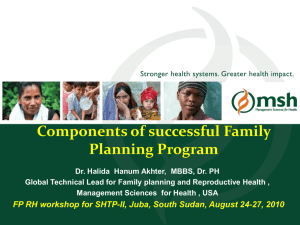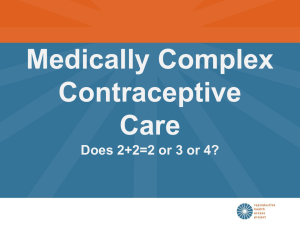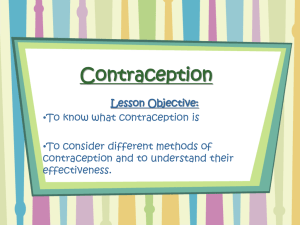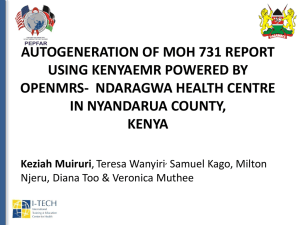English
advertisement
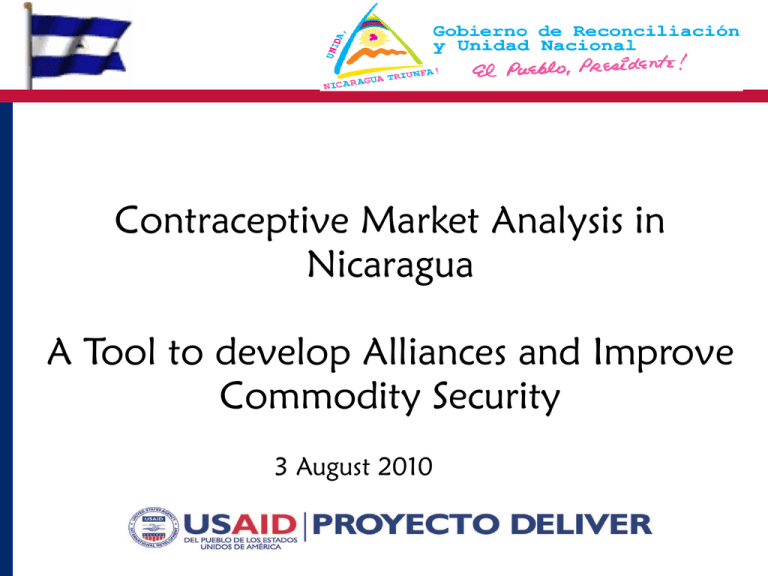
Contraceptive Market Analysis in Nicaragua A Tool to develop Alliances and Improve Commodity Security 3 August 2010 ¿What is a Market Analysis? • A tool to analyze access to services and define strategies to segment, focus, and ensure equitable resource allocation: – Utilizes each country’s demographic surveys – Analyzes contraceptive use, demand, and provision in the whole market (public and private). – Groups clients according to characteristics, needs and/or common preferences. Why is a Market Analysis Conducted? • To better understand clients’ needs • To better understand coverage and institutional potential to satisfy demand • To ensure more effective and efficient use of resources assigned to each institution to provide family planning services What are the Benefits of a Market Analysis? • A more complete outlook – Sharing information and data helps stakeholders better understand the market they are working in. • The supply adapts to demand – When coordinating service provision among all actors to better fulfill clients’ needs, the supply is tailored to demand and gaps to access are reduced. • Client Satisfaction - Clients can have better access to their method of choice, from a convenient source and at a fair price. Market analysis helps us monitor progress in: • CS in our country • FP/SRH indicators • Coverage of the different actors Let’s see a few examples of ….. Methodology Geographical Analysis • Identified departments with wider gapt to FP access, based on ethnic, economic, educational aspects, CPR in women of reproductive age, unmet need for contraceptives and others • Data are reflected on maps to visualize the distribution of each variable and analyze the areas with wider gaps in access Market Analysis • ENDESA 2001 and ENDESA 2006-07 secondary data analysis • Each home is classified according to the availability of goods and services – Provides an approximate indicator of socio-economic level: classification by quintiles Quintile Analysis Proxy for socio-economic rate based on having goods and services Q5 20% of homes with highest socioeconomic rates Q4 Q3 Q2 Q1 20% of homes with lowest socio-economic rates Total Fertility Rate (TFR) Total Fertility Rate Trends: 1992-2007 5 4.5 4.6 4 3.9 3.5 Total Fertility Rates by Quintile: 2006-07 3.3 3 2.7 2.5 5 2 1.5 4.5 4 1 3.0 0.5 3 2.6 0 1992-93 1998 2001 2006-07 2 1.9 1.8 Q4 Q5 1 0 Q1 Q2 Q3 Contraceptive Prevalence Rate Trends 80 70 66 60 50 60 57 71 69 66 75 72 70 60 Total 52 Modern Methods Traditional Methods 40 Urban Rural 30 20 10 0 2.6 1998 2.5 2001 2.6 2006-07 Contraceptive Use by Quintile 2006-07 100% 90% 80% 34.8 30.2 25.3 24.5 21.4 70% 60% 10% 15.3 13.7 28.6 28.7 32.9 30% 20% 19.3 13.5 27 50% 40% 22.1 12.3 13.6 12.6 21.9 32.4 12.6 0% Q1 Q2 Q3 Q4 Q5 TPA 65% TPA 70% TPA 75% TPA 76% TPA 79% Does not use Traditional Methods Other modern Male Condom Injectable IUD Pill Female Sterilization Method Mix 100% 4.3 5.2 8.7 80% 15.2 32.3 Traditional Methods Other modern 60% 23.2 4.7 18.6 40% Male Condom Injectable IUD Pill Female Sterilization 20% 43.5 33.6 0% 1998 2006-07 Method Mix by Quintile 2006-07 100% 90% 80% 70% 38.7% 29.6% 25.6% 17.2% 50.5% 60% 50% 15.6% 38.3% 38.0% 41.2% Q3 Q4 Q5 19.3% 20% 10% 18.1% 19.5% 40% 30% 20.5% 31.4% 19.3% 0% Q1 Q2 Traditional Methods Other modern Male Condom Injectable IUD Pill Female Sterilization Method Mix by Residence Area 2006-07 100% 90% 80% 24.4 42.3 70% 60% 4.9 50% 13.1 40% Male Condom Injectable 1.6 IUD 14 Pill Female Sterilization 30% 20% Traditional Methods 38.6 27.3 10% 0% Urban Rural Unmet Need: Traditional Definition “women who are not pregnant, do not want to be pregnant, are at reproductive risk and do not use contraception” Prevalence and Unmet Need 2001 2006-2007 Do not use 16.9% Do not use 16.8% Need FP 10.7% Need FP 14.6% Traditional Methods 2.6% Traditional Methods 4.3% Modern Methods 69.8% Modern Methods 64.3% FP Services Need by Quintile 2006-07 100 90 11.1 8.9 7.3 74.7 75.5 78.6 65.2 69.8 Q1 Q2 Q3 Q4 Q5 % women in union 80 70 13.3 12 60 50 40 30 20 10 0 Met Need for FP Unmet Need for FP Total Unmet Need: 10.7% Unmet Need by Geographic Area: 2001 and 2006-07 100 15.1 14.6 80 11.5 10.5 70 4.0 3.6 90 19.0 19.6 18.7 10.9 1.5 Do not use Need for FP 4.8 60 50 Traditional Methods Modern Methods 40 69.4 71.3 30 68.0 57.5 20 10 0 Urban 2001 Urban 2006-07 Rural 2001 Rural 2006-07 Contraceptive Source 100% 6.2 4.5 2.8 11.4 12.4 14.6 11.9 9.8 5.0 3.9 7.1 6.5 80% 3.6% Other source/Does not know Other NGOs 60% Pharmacy/Market PROFAMILIA Private Clinic/Hospital/Provider 40% Community Sector 62.0 63.6 1998 2001 67.8 Previsional Medical Company Public Sector (MOH) 20% 0% ENDESA 2006-07 Contraceptive Source by Quintile 100.0 1.5 90.0 80.0 5.0 2.7 0.2 2.1 8.3 2.6 20.6 5.2 2.3 3.5 70.0 4.6 14.4 4.5 1.2 3.7 26.0 4.8 4.3 5.8 60.0 7.0 12.2 50.0 40.0 83.2 8.3 80.2 41.0 20.0 10.0 0.0 Q2 Q3 Other NGOs Pharmacy/Market PROFAMILIA Private Clinic/Hospital/Provider Community Sector Public Sector (MOH) 59.3 Q1 Other source/Does not know Previsional Medical Company 71.1 30.0 2006-07 Q4 Q5 Contraceptive Source by Geographic Area 100% 90% 20.2 80% 70% 60% 7.5 4.3 1.6 0.9 Other source/Does not know 5.4 5.8 5.7 Other NGOs Pharmacy/Market PROFAMILIA 50% Private Clinic/Hospital/Provider 79.0 40% 30% 2006-07 Previsional Medical Company 58.3 Public Sector (MOH) 20% 10% 0% Urban Community Sector Rural Source of Oral Contraceptives by Quintile 100 90 80 11.5 0.0 2006-07 18.9 1.3 35.5 48.9 70 58.9 Other NGOs 2.7 60 Other source/Does not know Pharmacy/Market PROFAMILIA 50 40 3.3 79.3 Community Sector 74.9 30 Private Clinic/Hospital/Provider 6.9 59.1 Public Sector (MOH) 41.9 20 24.5 10 0 Q1 Q2 Q3 Previsional Medical Company Q4 Q5 Source of IUDs by Quintile 100 6.8 5.9 12.5 11.8 3.4 90 11.0 6.3 80 4.1 13.0 5.0 70 Other source/Does not know 60 25.3 50 2006-07 93.3 Other NGOs Previsional Medical Company 88.6 40 86.5 PROFAMILIA 76.3 Private Clinic/Hospital/Provider 30 Public Sector 42.5 20 10 0 Q1 Q2 Q3 Q4 Q5 Source of Injectables by Quintile 100 5.1 90 6.2 9.4 2006-07 3.8 26.9 80 38.0 70 5.9 Other source/Does not know 60 4.3 4.1 50 87.4 89.5 40 Other NGOs Pharmacy/Market PROFAMILIA 84.7 Private Clinic/Hospital/Provider Community Sector Previsional Medical Company 62.3 30 50.2 20 10 0 Q1 Q2 Q3 Q4 Q5 Public Sector (MOH) Source of Sterilizations by Quintile 100 90 3.3 12.6 1.4 4.6 8.1 12.6 3.3 80 5.4 13.5 2.9 12.5 2006-07 10.7 6.2 70 7.4 60 12.1 16.2 Other source/Does not know Other NGOs 50 Previsional Medical Company 40 84.1 79.0 PROFAMILIA 74.9 Private Clinic/Hospital/Provider 68.0 30 Public Sector (MOH) 51.4 20 10 0 Q1 Q2 Q3 Q4 Q5 Source of Condoms by Quintile 100 7.5 2006-07 90 80 51.1 70 66.8 60 Other source/Does not know 77.3 91.2 50 Pharmacy/Market Previsional Medical Company 90.9 PROFAMILIA 40 Private Clinic/Hospital/Provider Community Sector 5.4 30 Public Sector (MOH) 46.7 20 24.7 10 18.8 7.7 0 Q1 Q2 Q3 Q4 Q5 Method Mix: Health Insurance Beneficiaries Condom 5.5% Other 0.3% Injectable 22.6% Female Sterilization 57.0% IUD 8.7% Pill 18.2% Vasectomy 1.7% Distribution of Health Insurance Beneficiaries by Supply Source 100% 1.6 5.6 0.7 3.3 18.9 20.7 9.3 4.2 8.3 90% 80% 70% 60% 50% 16.0 2.8 19.9 2001 and 2006-07 Other source/Does not know Other NGOs Pharmacy/Market PROFAMILIA Private Clinic/Hospital/Provider 40% Community Sector 30% 20% Previsional Medical Companies 45.8 42.8 2001 2006-07 10% 0% Public Sector (MOH) Intention to use FP in Non-Users 2001 2006-07 Does not Other/traditional know/NA 1% 5% NS 5% Traditional 2% Female Sterilization 20% Pill 24% Pill 22% Female Sterilization 22% Condom 2% Condom 3% IUD 8% IUD 6% Inyectable 38% Injectable 42% Need to reach adolescents to be able to … • Meet their demand for services • Reduce unmet need • Offer them the most appropriate services Let’s see some examples Concentration of the adolescent population (15 to 19 years) in union, 2006-07 Contraceptive Use by Age and Total 100 90 80 CPR all methods CPR modern methods Female Sterilization Pill IUD Injectable Male Condom Does not Use 70 60 50 40 30 20 10 0 15-19 20-24 25-29 30-34 35-39 40-44 45-49 Contraceptive Source by Age: 2006-07 100% 80% 22.2 17.1 19.7 13.7 11.2 8.4 5.4 10.0 0.5 1.3 0.1 3.8 10.2 12.4 Other source/Does not know Other NGOs Pharmacy/Market 60% Previsional Medical Company PROFAMILIA 40% 69.8 72.7 Private Clinic/Hospital/Provider 68.1 68.2 63.0 61.9 68.8 Community Sector Public Sector 20% 0% 15-19 20-24 25-29 30-34 35-39 40-44 45-49 Contraceptive Prevalence Rate By Age: 2006-07 90% 80% 70% 60% 50% 40% 30% 20% 10% 0% 82% 81% 71% 74% 59% 61% Sexually Active - Not in Union Currently in Union 15-19 20-24 25-29 Client Method Preference: 2006-07 (15-19) Other, 4.5% Female Sterilization, 3.6% Pills, 21.4% Injectable, 61.6% Copper T or IUD, 8.9% Non-User Method Preference: 2006-07 (15-19) Progress • The use of modern methods has increased, mainly in quintile 1 • Gap in CPR between rural and urban area has been closed • Unmet need for FP and TFR has decreased, but % of non-use is the same • The use of traditional methods methods has remained the same between 1998 and 2006-07, with a slight increase in the urban area • Previsional medical companies (part of the national insurance scheme) began to offer more FP services To Analyze…(1) • Method mix shows a great disparity between rural and urban area • Difference in CPR and TFR betweenntre Q1 and Q5 is still significant • The public sector is the main provider of contraceptives, but provides services to an important % of quintiles 4 and 5 • The NGO sector has shrunk, reflecting a slight increase in pharmacies • An important % of quintiles 1 and 2 obtain their methods from pharmacies and NGOs • Clients with private insurance go mainly to MOH sites To Analyze…(2) • Intention of future use among women of reproductive age is concentrated in injectables, followed by sterilization • Use and future preference for the IUD, being a cost-effective and innocuous method, has decreased • The higher maternal mortality rates are concentrated in the departments with higher TFRs and lower long term and permanent methods • 54% of women between 15-24 years prefer the injectable and 26% the pill • 79% of adolescents want to use contraceptives in the future Challenges (1) Can the MOH continue fulfilling the needs of every sector of the population? ¿Does it have the financial resources to do this? ¿Where should it focus its efforts, considering budget limits and the global financial crisis? Are the institutions and services prepared to fulfill the current market, and especially, the future market? How can FP services be increased in previsional medical clinics and social security institute sites and have cost-effective methods? Challenges (2) How can access to long term methods be improved in rural areas? How can we ensure access to modern methods for adolescents? What strategies must the public sector develop for people who have the capacity to pay to go to private services? What changes must be considered in form and content to provide appropriate reproductive health counseling? What does the private sector need to improve access to FP in quintiles with the capacity to pay? What role should NGOs play in the supply of FP methods and services? How can we ensure sustainability in this endeavor? ¿How can Countries and Institutions Improve?…. ¿How can we create inter-institutional synergies to reduce disparities and unmet need for Family Planning services? ¡Without Products… …There is No Program!
